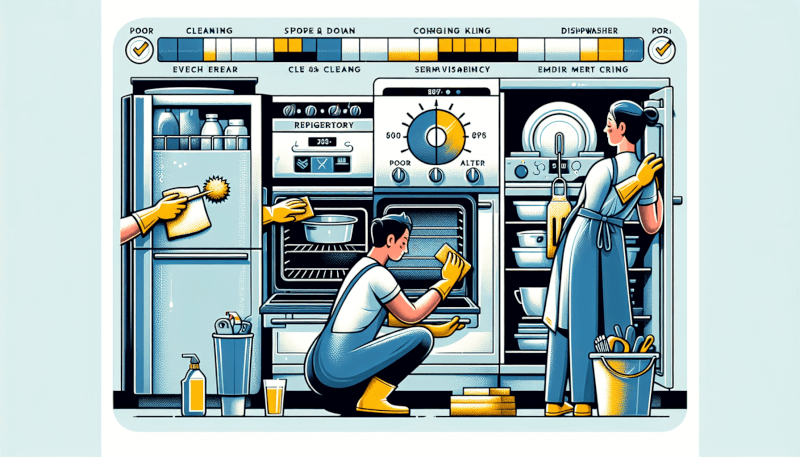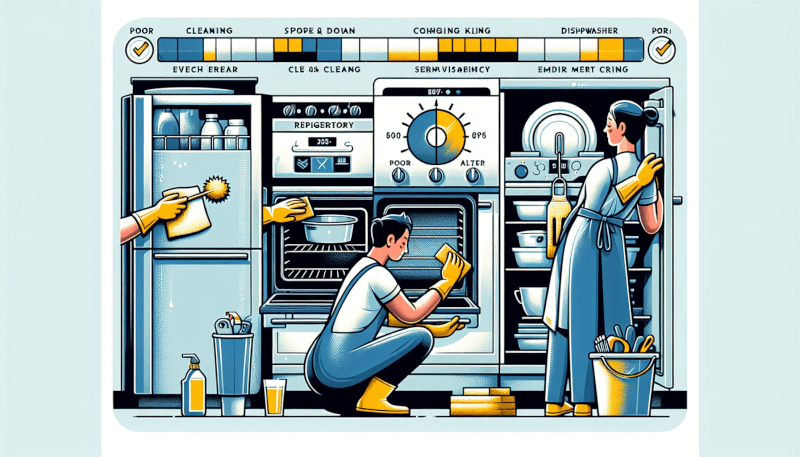In this article, you will discover the essential tips and tricks on how to effectively clean and maintain your kitchen appliances. From your trusty stove to your reliable refrigerator, we will guide you through the process of keeping your appliances in tip-top shape. With our friendly and easy-to-follow advice, you will learn the best techniques to ensure the longevity of your appliances, saving you time and money in the long run. So, let’s dive right in and find out how you can achieve a sparkling clean and well-maintained kitchen for years to come.
Cleaning and Maintenance of Kitchen Appliances
Importance of Cleaning and Maintaining Kitchen Appliances
Taking care of your kitchen appliances is essential to ensure their longevity and efficiency. Regular cleaning and maintenance not only keep your appliances in good working condition but also promote food safety and prevent the buildup of dirt, grime, and bacteria. By following a few simple cleaning and maintenance tips, you can extend the life of your kitchen appliances and enjoy their full functionality for years to come.
General Cleaning Tips for Kitchen Appliances
When it comes to cleaning your kitchen appliances, it’s important to take a gentle, yet effective approach. Here are some general cleaning tips to keep in mind:
Read the manufacturer’s instructions: Before you start cleaning any appliance, always refer to the manufacturer’s instructions for specific cleaning recommendations and guidelines. Following these instructions will ensure you don’t damage any sensitive parts or void your warranty.
Unplug the appliances: Before you begin cleaning, make sure to unplug the appliances for safety purposes. This will prevent any accidents and ensure that you can safely access all the nooks and crannies.
Use mild, non-abrasive cleaners: Opt for mild, non-abrasive cleaners that are suitable for the specific material of your appliance. Avoid using harsh chemicals or abrasive sponges that can damage the surface or leave behind scratches.
Remove detachable parts: For thorough cleaning, remove any detachable parts such as shelves, drawers, or racks. Clean them separately using warm, soapy water, and dry them thoroughly before reassembling.

Cleaning Specific Kitchen Appliances
Now let’s discuss some specific cleaning techniques for different kitchen appliances:
1. Cleaning Refrigerator
The refrigerator is the heart of the kitchen, and it’s crucial to keep it clean to maintain food safety and prolong its lifespan. Here’s how you can clean your refrigerator effectively:
- Start by emptying the contents of your refrigerator and discarding any expired or spoiled food items.
- Remove all the removable shelves, drawers, and racks and wash them with warm, soapy water.
- Wipe down the interior surfaces of the refrigerator with a mixture of water and mild dish soap. Pay special attention to any spills or stains.
- Use a clean cloth or sponge to clean the exterior surfaces of the refrigerator, including the handles and door seals.
- Lastly, don’t forget to clean the condenser coils located at the back or underneath the refrigerator. Use a vacuum cleaner or a specialized coil cleaning brush to remove any dust or debris.

2. Cleaning Stove/Oven
Keeping your stove and oven clean not only improves their performance but also enhances the taste of your cooked meals. Follow these steps to clean your stove and oven effectively:
- Remove any loose debris or food particles from the stovetop and burner grates. You can use a soft brush or a damp cloth for this.
- For gas stovetops, remove the burner grates and soak them in warm, soapy water. Scrub them gently to remove any grease or stains.
- Wipe down the stovetop with a mixture of water and dish soap, paying extra attention to any food spills or stains.
- For electric stovetops, use a smooth-top cleaner or a mixture of baking soda and water to remove any stubborn stains. Use a non-abrasive sponge or cloth for scrubbing.
- To clean the oven, remove the oven racks and clean them separately. Use a mixture of baking soda and water or a commercial oven cleaner to coat the interior surfaces. Let it sit for a while before scrubbing away any grime or residue.
- Lastly, wipe down the exterior surfaces of the stove and oven with a damp cloth.
3. Cleaning Microwave
Microwaves are prone to food splatters and odors, so regular cleaning is essential. Here’s how you can clean your microwave effectively:
- Fill a microwave-safe bowl with water and add a few slices of lemon or a tablespoon of vinegar.
- Heat the bowl in the microwave on high power for 3-5 minutes until the water boils and creates steam. Let it sit for a few minutes to allow the steam to loosen any food debris or stains.
- Carefully remove the bowl and use a damp cloth or sponge to wipe down the interior surfaces of the microwave, including the door and the turntable.
- For stubborn stains or sticky residue, create a paste using baking soda and water. Apply this paste to the stains, let it sit for a few minutes, and then scrub it away with a non-abrasive sponge or cloth.
- Finally, wipe down the exterior surfaces of the microwave with a clean, damp cloth.

4. Cleaning Dishwasher
Cleaning your dishwasher once in a while helps remove built-up grease and grime, prevents clogs, and keeps your dishes clean. Follow these steps to clean your dishwasher effectively:
- Start by removing any food debris or leftover dishes from the dishwasher.
- Take out the removable trays, racks, and utensil holders and wash them with warm, soapy water. Use a toothbrush or a small brush to scrub away any stubborn residue.
- Check the dishwasher filter and remove any debris or clogs. Rinse it under running water to ensure it’s clean.
- Place a dishwasher-safe cup filled with white vinegar on the top rack of the dishwasher. Run a hot water cycle to remove any limescale or buildup.
- If there are any stains or odors, sprinkle baking soda on the bottom of the dishwasher and run another hot water cycle.
- Wipe down the exterior surfaces of the dishwasher with a damp cloth.
5. Cleaning Coffee Maker
Regular cleaning of your coffee maker not only ensures a great-tasting coffee but also prevents the buildup of mineral deposits. Here’s how to clean your coffee maker effectively:
- Fill the water reservoir with equal parts of water and white vinegar.
- Place a coffee filter in the filter basket and run a brew cycle. Let the vinegar and water solution sit in the carafe for about 15 minutes to descale the machine.
- Discard the vinegar solution and rinse the carafe and filter basket with clean water.
- Run a few cycles of clean, fresh water through the coffee maker to remove any vinegar residue.
- Wipe down the exterior of the coffee maker with a damp cloth.

6. Cleaning Blender
Cleaning your blender after every use prevents the accumulation of residues and ensures proper hygiene. Follow these steps to clean your blender effectively:
- Fill the blender jar halfway with warm water and add a few drops of dish soap.
- Secure the lid on the blender and blend the soapy water on low or medium speed for a few seconds.
- Remove the jar from the base and discard the soapy water.
- Rinse the jar thoroughly with clean water and dry it before reassembling.
- For the blender base, unplug the appliance and wipe it down with a damp cloth. Do not submerge the base in water.
7. Cleaning Toaster
Cleaning your toaster regularly helps remove crumbs and prevents any fire hazards. Here’s how to clean your toaster effectively:
- Unplug the toaster and remove the crumb tray. Discard any crumbs or debris.
- Use a soft brush or a clean cloth to remove any crumbs from the toaster slots.
- Mix equal parts of water and vinegar and dampen a cloth or sponge with this solution. Wipe down the exterior surfaces of the toaster, including the control knobs or buttons.
- Dry the crumb tray thoroughly before reinserting it into the toaster.

8. Cleaning Food Processor
To maintain the performance and longevity of your food processor, regular cleaning is essential. Follow these steps to clean your food processor effectively:
- Separate the removable parts from the food processor, such as the bowl, lid, and blades.
- Place them in warm, soapy water and let them soak for a few minutes.
- Use a non-abrasive sponge or brush to wash the parts thoroughly, removing any food residues.
- Rinse the parts with clean water and dry them completely before reassembling.
- Wipe down the food processor base with a damp cloth.
Maintenance Tips for Kitchen Appliances
Apart from regular cleaning, here are some maintenance tips to keep your kitchen appliances in optimal condition:
1. Regular Inspection and Maintenance
Periodically check your kitchen appliances for any signs of wear or damage. Look for loose knobs, frayed cords, or malfunctioning parts. If anything seems amiss, contact a professional technician for repairs or replacements.
2. Cleaning Filters and Vents
Many kitchen appliances, such as range hoods and dishwashers, have filters or vents that require regular cleaning. These filters and vents can become clogged with grease, dust, or debris, affecting the performance of the appliance. Follow the manufacturer’s instructions to clean and replace these filters regularly.
3. Proper Ventilation
Ensure proper ventilation for your kitchen appliances, such as your stove or oven. Adequate ventilation prevents the buildup of heat, moisture, and odors, reducing the risk of damage and enhancing the lifespan of the appliances.
4. Lubricating Moving Parts
For appliances with moving parts, such as blenders or food processors, lubrication is crucial to ensure smooth operation. Check the manufacturer’s instructions for the recommended lubricant and apply it to the appropriate areas as needed.
5. Avoiding Overloading and Misuse
To prevent excessive strain or damage to your kitchen appliances, avoid overloading them beyond their recommended capacity. Additionally, use appliances for their intended purposes and follow the user manual’s guidelines to avoid misuse.
6. Dealing with Appliance Smells
If you notice any strange odors emanating from your kitchen appliances, such as a refrigerator or dishwasher, there are a few simple remedies you can try. For refrigerators, clean out any spoiled food and place an open box of baking soda to absorb odors. For dishwashers, run a cycle with white vinegar or use specialized dishwasher cleaning solutions to eliminate any unpleasant smells.
By implementing these cleaning and maintenance tips, you can keep your kitchen appliances performing at their best, extend their lifespan, and ensure a clean and safe kitchen environment. Remember to always refer to the manufacturer’s instructions for specific cleaning and maintenance guidelines for each appliance. Happy cleaning!


